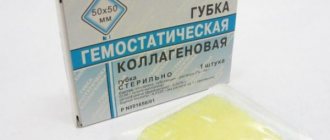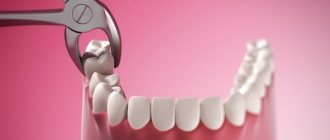Features of wound healing after tooth extraction
Before moving directly to hemostatic sponges, what they consist of and how to use them, you need to understand how the wound heals after removal and what can go wrong here. More on this later.
Why is there bleeding after removal?
Bleeding is a natural reaction to surgery. After all, when a tooth is removed, the smallest capillaries that penetrate the gums and ligamentous apparatus - the periodontium, which attaches the roots to the bone socket - are torn. And with difficult removal, the bleeding may be even stronger, because... The dentist makes incisions in the gums and drills into the jaw bone - the tissue is more damaged.
Bleeding is a natural reaction to surgery
Read on the topic: How long can a tooth hurt after extraction - normal and pathological.
How long does bleeding last normally?
Normally, the blood stops within 15-20 minutes (less often, within 45 minutes) and a blood clot forms in the socket. It seals the hole like a cork, preventing germs from penetrating inside. If the patient has problems that affect blood clotting, then the bleeding time is prolonged, and a clot may not form at all. And this is already fraught with inflammation of the bone socket (the pathology is called “alveolitis”). Therefore, according to indications, the dentist applies a hemostatic drug to the area of the extracted tooth.
On a note! Bleeding may appear again for a short time (and there will be quite a bit of blood) after the anesthetic wears off - if it contained adrenaline. This substance narrows the blood vessels in the intervention area, and as they expand normally, slight bleeding occurs. It goes away quickly.
Why does the bleeding not stop for a long time?
As a rule, after tooth extraction, the dentist says that you should not eat or drink for 2 hours. But few people say that you should not rinse your mouth or suck drinks out of a straw. In the first days, only oral baths are allowed, and it is better to drink in the usual way. Also, do not touch the wound with a brush. It is better to chew food on the healthy “side” of the jaw. Otherwise, there is a risk of moving or “pulling” the clot out of the hole - which will provoke new bleeding or even inflammation, which will result in long-term treatment.
The following groups of patients are also at risk:
- who has not formed a blood clot,
- with blood diseases,
- who takes blood clotting medications,
- having high blood pressure,
- women during menstruation or menopause,
- exposing themselves to physical activity immediately after removal and during the recovery process,
- if there was already inflammation at the extraction site (for example, pericoronitis above a wisdom tooth),
- during complex operations: when several teeth were removed at the same time, or manipulations were performed with increased tissue trauma.
Bleeding may occur during physical exertion after removal.
When you need urgent help
If the bleeding is profuse and does not stop for a long time, if after normalization of the condition the blood begins to ooze heavily again, this is a reason to consult a dentist. In a situation where the patient, in the presence of continuous bleeding, feels weakness, apathy, if the temperature has risen sharply (above 39 degrees Celsius), it is better to call an ambulance or go to the hospital on your own.
Features of socket healing after extraction
A few minutes after the collagen sponge is placed on the tooth socket, the bleeding should stop. But there is no need to remove the sponge - it should remain on the wound until it resolves on its own (usually this takes two to three weeks). The wound itself will heal a little during this time period.
- Gums bleed after tooth extraction
How long does bleeding last after tooth extraction and what to do if it doesn’t stop?
Important! Damaged tissues are restored much faster than if this happened without the use of a hemostatic sponge.
Causes of prolonged bleeding of the socket
Upon completion of the operation, bleeding begins due to the fact that blood vessels, soft tissues (and sometimes even bones) have been damaged. All these are primary reasons.
Bleeding from the socket
But there are also secondary ones, which include:
- the end of the action of an anesthetic containing adrenaline (the latter, as is known, constricts blood vessels);
- non-compliance with the dentist's recommendations;
- hypertension (the socket may bleed due to high pressure). If the disease has worsened, extraction is strictly prohibited;
- wide opening of the oral cavity;
- disorders associated with blood clotting;
- inflammation at the extraction site;
- taking blood thinning medications;
- traumatic operation.
Tooth extraction
How long should a hole bleed?
The question of how long blood normally flows after extraction worries many. If there are no diseases, and the extraction was carried out correctly, then the blood flows for about 10-15 minutes (in more rare cases - 35-40 minutes). Simply put, the bleeding should stop in the dentist's office.
When a tooth is removed, a hole remains in its place (sometimes without or with a blood clot). The clot itself is a natural reaction of the body to the intervention, evidence that the wound will heal well. This is why you should not rinse your mouth, spit, or suck out blood for several hours after surgery.
2 weeks after removal
Important! There is a hole that has started to bleed already at home, this indicates a violation; in this case, you need to urgently visit a doctor. If the bleeding is very heavy, call an ambulance, and if it is not severe, you can try to cope with it at home.
When is a doctor needed?
You should see a doctor if:
- there was heavy bleeding;
- sharp pain appeared;
- it is not possible to stop the bleeding for more than 1 hour;
- impurities of pus are observed in the blood;
- you feel weak, dizzy, headaches;
- body temperature increased;
- pain occurs when touching the gums;
- area of the jaw is swollen.
Tumor after tooth extraction
On a note! In addition to the hemostatic sponge, bleeding can be stopped by other methods. Let's take a closer look at them.
Table. Alternative ways to stop bleeding.
| Name, photo | Short description |
| Tamponade | The most popular method, which is used not only after tooth extraction, but also to stop bleeding from the ears and nose. Apply a sterile swab (bandage or gauze) to the desired area, squeeze the edges of the hole and bite down without pressing too hard. Thanks to this, the vessels subjected to mechanical pressure stick together, and bleeding stops. The tampon must be held for approximately 15-20 minutes. |
| Hydrogen peroxide | You need to moisten a sterile swab in 3% hydrogen peroxide, then apply it to the wound for about 20 minutes. Peroxide promotes blood clotting. |
| Cold compress | Cold may slow or even stop bleeding. Apply something cold to the area where the operation was performed (you can use not only ice, but also frozen foods or some improvised items). To avoid damage to the skin, it is recommended to wrap the cold in a soft cloth. The compress can be applied for a maximum of 5 minutes. After another 5 minutes, you can repeat the procedure. |
What is a hemostatic sponge
Now let's move on to why a hemostatic sponge is placed in the hole left after tooth extraction? Let's first understand the terminology. “Hemo” means “blood” and “stasis” means stopping. Those. a hemostatic sponge is needed to stop bleeding. In simple terms, this is a kind of replacement for a blood clot. The hemostatic sponge in the tooth socket not only seals the open cavity, but also has a hemostatic effect. Firstly, it puts pressure on small vessels, stopping bleeding. Secondly, it absorbs excess blood, increasing several times. The bleeding stops within 2-3 minutes.
On a note! By the way, local hemostatic agents are used not only in dentistry, but also in other areas of medicine - for example, hemostatic bandages successfully replace tourniquets that are applied for bleeding.
What is a sponge for?
The thing is that for “healthy” healing, the postoperative hole must be “closed” with a blood clot (thrombus). If this does not happen, the wound will heal much more slowly, and the likelihood of complications increases several times. Thus, the formed blood clot is a kind of biological bandage that does not allow saliva containing pathogenic microorganisms to “attack” the empty socket.
But there are times when after surgery a blood clot does not form (dissolves), and blood begins to flow from the wound. Most often, this abnormal phenomenon is associated with damage to bone tissue during surgery. But along with this, there are other reasons:
- bleeding disorders;
- active inflammatory processes in the postoperative wound (on the gums);
- injuries of large vessels;
- damage to the blood clot itself, blocking the hole;
- taking certain medications;
- non-compliance with the dentist’s recommendations for caring for the oral cavity in general and the wound in particular after extraction.
Pharmacies offer a wide range of GGs, which contain medications.
It is to eliminate postoperative bleeding from the socket that a hemostatic sponge (hereinafter referred to as HS) is used.
Appearance and release form
The hemostatic sponge looks like a cube or plate, which looks like a small sponge or a piece of yellow or white foam rubber. Although in fact it consists mainly of natural collagen with various medicinal additives. The plate is quite soft and easy to cut, which allows the dentist to cut the desired size according to the shape of the hole.
The plate is quite soft and easy to cut
Manufacturers produce both small (1x1 centimeter) and large sponges (10x10 cm). The plates are tightly sealed in transparent bags, and the cubes are sealed in dark, opaque bottles. Hemostatic powders and gels are also produced. Absolutely all collagen hemostatics dissolve on their own in the wound over time.
Types of hemostatic sponges
According to the manufacturing method, hemostatic sponges for teeth are of the following types:
- from donor blood plasma - amben,
- from bones/tendons/blood of cattle - collagen and gelatin.
You need to understand that a hemostatic agent not only stops bleeding (due to aminocaproic acid, for example) and stimulates the formation of a blood clot, but also has an antiseptic effect. It can also accelerate regeneration and relieve inflammation. It all depends on the active components that make up the hemostatic sponge. The drug can be impregnated with the following substances:
- antiseptics: chlorhexidine, furatsilin, silver suspension, boric acid, iodoform,
- local anesthetics: for example, lidocaine,
- preparations for bone regeneration: calcium phosphate,
- antibiotics: metronidazole, chloramphenicol, neomycin, gentamicin, etc.,
- natural substances: propolis, eugenol, etc.
Hemostatic sponges for teeth come in different types
Types of GG
There are two main types of sponges - those made from donated blood and those made from blood, tendons, blood, bones of cattle. The blood contains the following active components, such as thrombin, thrombokinase, and salts. It is thanks to these substances that the healing properties of GG are ensured.
Antibiotics for tooth extraction
Based on additional components, sponges are divided into:
- collagen (based on cattle bones and tendons);
- gelatinous (contains only livestock bones);
- amben (with elements of human blood plasma, sold only with a doctor's prescription).
GG may contain Furacilin, Nitrofural, boric acid and other medicinal components. Depending on the composition of GG, you can find products in pharmacies in different packages and with different names. As a rule, these are sealed blisters with one plate. Ambien tampons are packaged in dark glass vials.
Manufacturers of hemostatic sponges
Popular manufacturers of hemostatic agents used by dentists in our country are domestic companies. Let's consider them further:
- Alvostaz compress from Omega-Dent: available in the form of cubes, flagella, powders and solutions. The compresses are numbered - “1” with iodoform, “2” with metronidazole and chlorhexidine, “3” with neomycin and chloramphenicol,
- "Gemasept" with gentamicin from the Russian Research Institute of Hematology and Transfusiology of the Federal Medical and Biological Agency",
- “Collagen hemostatic sponge” with silver and boric acid from “Zelenaya Dubrava”,
- “Hemostatic sponge” with furatsilin and boric acid from “Belkozin”.
Indications for use
A hemostatic sponge can be useful after tooth extraction, especially wisdom teeth. Because the “eights” often do not erupt completely, and the dentist has to perform a mini-operation to get to them and remove them along with the roots. When a tooth is removed, a hemostatic agent is placed 3-4 months before implantation to completely eliminate the possibility of complications and problems with the formation of new bone in the socket.
Also, hemostatic sponges or powders are used during operations on the gums1 - plastic surgery, curettage of gum pockets (removal of deep “deposits” of tartar), and when cutting off dead areas of the jaw bone due to osteomyelitis. In the latter case, bone blocks and materials for regeneration of bone substance are additionally planted. In general, the doctor always assesses the patient’s condition in advance - asks about diseases and other conditions, and about the medications taken. If there is a risk of bleeding or poor regeneration, then rest assured, a hemostatic sponge will definitely be placed in the hole.
These sponges are used for bone augmentation
It is important to know! A few days after tooth extraction, it may be necessary to apply a hemostatic sponge if the dentist sees a tendency to worsen. For example, a clot has fallen out or the gums/bone have become inflamed.
How to use the drug correctly
How to use the sponge? The hemostatic sponge is placed into the socket of the extracted tooth only by the dentist. Home use is not recommended due to the risk of infection deep into the tissues. The application procedure is given step by step below:
- tooth extraction or treatment of the hole a few days after removal: in the latter case, purulent masses are removed, irrigation is carried out with an antiseptic,
- a piece of the hemostatic plate is cut off with sterile scissors or a hemostatic cube is taken with tweezers,
- the drug is placed in the hole and pressed with a flat instrument: if the hemostatic agent is pre-saturated with thrombin, the hemostatic effect is enhanced,
- if necessary, an additional piece of hemostatic is applied,
- if necessary, a small tampon is placed on top of the hole (it will be removed the next day),
- suturing the gums - a seam in the shape of the letter “P”: also, if necessary, in most cases you can do without stitches.
A piece of the hemostatic plate is cut with sterile scissors.
Basic properties
In the tooth socket, the hemostatic sponge performs certain functions:
- Thanks to physical enlargement, it stops heavy bleeding.
- Stimulates the formation of a blood clot.
- Protects the hole from the penetration of bacteria and food particles.
- Accelerates tissue healing.
- Has anti-inflammatory, analgesic and wound healing effects.
Features of application
The dentist places the product into the socket of the extracted tooth immediately after surgery. If bleeding occurs at home, the patient independently performs a simple algorithm of actions:
- The procedure is carried out wearing sterile gloves. Hands and tools are cleaned and disinfected.
- A piece of tube of a given size is cut. The product is aligned to the shape of the wound.
- Using tweezers, the sponge is placed in the hole and pressed.
- When absorbed, the hemostatic increases in size. If necessary, an additional piece is placed on top.
- In some cases, it is necessary to sutured the edges of the wound.
How long does the sponge resorption process take?
Since the material is natural and consists mainly of collagen fibers, the sponge dissolves on its own. The resorption period is determined by the composition of the sponge. On average, the product disappears in 1-6 weeks. New tissues are formed instead of collagen.
The sponge material rarely provokes the development of allergic reactions. Impregnation of the sponge can provoke negative consequences. It is recommended to immediately inform your dentist about intolerance to medications or their components. If itching, redness, pain or burning occurs, you should immediately contact your dentist.
After surgery, you should not disturb the hole, remove the sponge from it, or touch the wound. Such actions can cause wound infection or tissue injury. In this case, long-term treatment will be required.
Contraindications and side effects
Side effects can develop if used incorrectly and inappropriately. If allergic reactions develop, you should immediately stop using the product and consult a doctor.
The sponge in the wound is completely inert. It does not provoke the development of side effects. If you experience discomfort, pain or swelling, you should immediately consult a doctor to ensure the quality of healing. Such symptoms may indicate the development of an inflammatory process and complications after surgery.
Hemostatic agents are the best solution for stopping primary or secondary bleeding after tooth extraction. A safe drug protects the wound from secondary infection and accelerates the healing process.
Is it necessary to remove the hemostatic agent?
Patients often wonder what to do with a hemostatic sponge after it has been placed in the socket of an extracted tooth? How long should I keep it on, and will it dissolve on its own? The rules of conduct are as follows: carefully but thoroughly observe oral hygiene, and also take medications prescribed by the dentist. There is no need to specially remove the hemostatic agent - after all, it consists of components that will completely dissolve during wound healing. And instead of a hemostatic agent, its own tissues form in the hole.
“When my wisdom tooth was removed, they stuffed it into the wound like a piece of foam rubber. I then saw the houses through the seams. I was also surprised - what is it? And at the next appointment, my dentist told me that this is a special sponge that absorbs blood and protects against infection. And when it resolved, I didn’t even notice)) It probably completely disappeared in a couple of weeks.”
Ekaterina R., review from irecommend.com
Contraindications and side effects
The only contraindication to the use of a hemostatic sponge after tooth extraction is an individual allergy to any of the components of the drug. In particular, for antibiotics that are used to impregnate the hemostatic agent. Therefore, be sure to tell your dentist if you are allergic and to what medications. Hemostatic agents should also be used with extreme caution in children.
There are no side effects, because There are no toxic substances or components that affect perception in hemostatics. But if itching, inflammation, or swelling appears, feel free to contact your dentist. These manifestations can be caused either by a newly manifested allergy or by incipient complications - if, for example, the treatment was carried out poorly or the patient did not follow the doctor’s instructions.
1Skulean A. Periodontal regeneration, 2012.
Hemostatic sponge. Instructions for use
Each package contains detailed instructions from the manufacturer - strictly follow them to avoid complications. The use of the drug has its own characteristics and nuances, and therefore only a qualified doctor can prescribe it, based on possible side effects and contraindications.
Are there any side effects?
A hemostatic sponge, like any other drug, can provoke the development of an allergic reaction. To avoid this, the dentist should ask the patient before the operation whether he has ever had an individual intolerance to any components of the medication. In addition, if you use a sponge, there will be a risk of re-infection of the wound.
What about contraindications?
As we just found out, the use of the product can provoke an allergic reaction, and therefore the sponge should not be used if the patient is intolerant of its individual components. In addition, contraindications include arterial bleeding from large vessels. Hemostatic sponges should be used with extreme caution in children.
How is the product used?
Everything is simple here - you need to remove the sponge from the package and place it on the hole left after tooth extraction. After a few minutes, when the bleeding stops, the sponge is saturated with blood and adheres tightly to the edges of the hole. If the bleeding does not stop, you can apply another sponge on top. When the bleeding stops, the sponge is fixed using a U-shaped suture. To enhance the therapeutic effect, you can moisten the sponge with thrombin solution.
The use of Alvostaz compresses also has its own characteristics. So, before use, the wound must be cleaned with warm saline, which the dentist then suctions out using a pipette. Next, the contents of the bottle are applied to the well and pressed down for several minutes with sterile gauze. If necessary, the tampon can be left in the hole, but not longer than 24 hours.
Note! The doctor must inform the patient that the gauze cannot be removed - after some time it will be rejected. If the damage is severe, the gauze may need to be changed several times.









